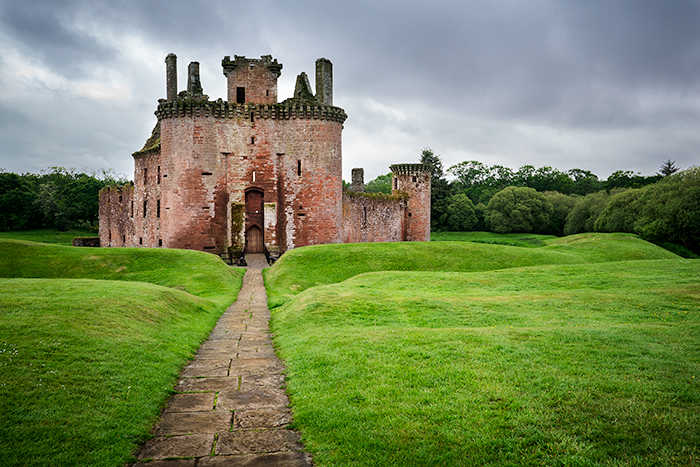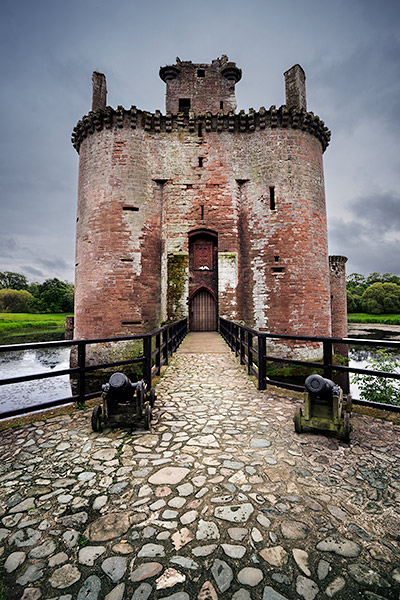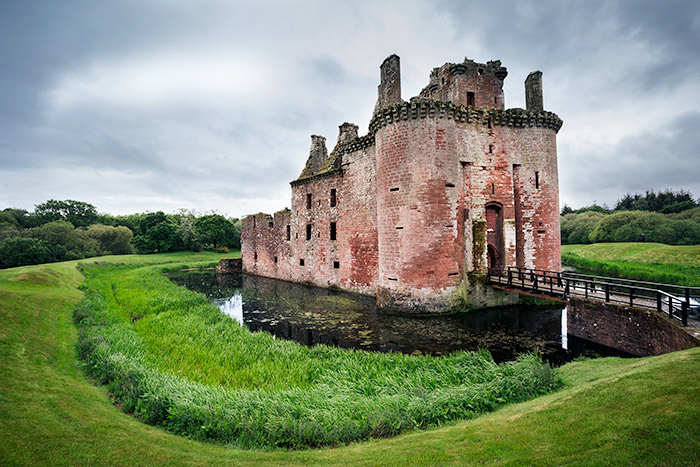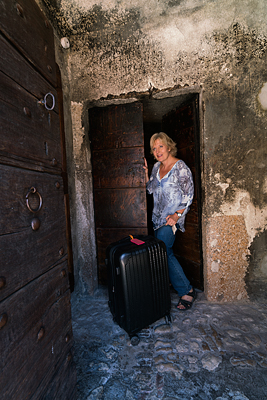

Caerlaverock meaning “fort of the skylark” seems a fitting name for Caerlaverock Castle in southern Scotland. This magnificent medieval fortress, located in a pastoral setting of gently rolling lands at the edge of Solway Firth, sits near a nature reserve with blinds for watching birds that flit about grasslands, swamp and marshes. Birdsong fills the air.
Not noise from traffic. Or crowds. Due to its remote location at the southern tip of Scotland, nine miles beyond Dumfries, few people venture here.
Soft carpeted lawns surround this pinkish-peach castle that—surprise—sits in a moat! Unique to the UK, Caerlaverock was also built in an unusual shape—a triangle. As you walk around the grassy green embankment wondering which fairytale could’ve been set here, don’t be surprised if you find yourself speaking in hushed tones. It’s only natural. Who wants to disturb the peace of a place so serene?
But it wasn’t always this quiet.


In fact, Caerlaverock Castle in southern Scotland was the site of many bloody battles over border conflicts with England and religion for over 300 years!
History of the castle


If you’re like me, visiting a site like this makes you want to know all about it. If those walls could talk! Reading about the recorded battles and events that created its history doesn’t come close to knowing what it was really like to live here. We can only envision our own stories and imagine their day to day life. So sticking to the facts, this is what I found…
Who built it?
Sir Herbert de Maxwell in 1277.
The Maxwell clan
The Maxwell Clan was a powerful family that rose to nobility with offices and appointed positions working for kings. Back in the 1200s, Sir Herbert de Maxwell was working as Chamberlain and trusted advisor to King Alexander II, who gave Herbert lands and funds to build a fortress on the southern border to help protect Scotland from England. The first castle, built in 1220, was located 200 meters closer to the sea and flooded easily. The family abandoned it and built this much grander fortress, Caerlaverock Castle, in 1277.
Home to Maxwell family for 400 years, this triangular fortress was attacked, captured, and returned to the Maxwells over conflicts between the English and Scots over borders and religion.
As was customary among Scottish nobility living near the Border, clan chiefs often changed sides during the Wars of Independence to form allegiance with the strongest power. Such was the case with the Maxwells, who contrived to be on the winning side, and by doing so accumulated titles, elevated positions, power, towers, castles and land as a result. (Many castles are tied to the Maxwells, including nearby Threave—which I’m still disappointed that we didn’t get to see.)
The last Earl of Nithsdale, William Maxwell, was a Jacobite supporter who was imprisoned in the Tower of London in 1715. He escaped the night before his execution by dressing in women’s clothing but died in exile in Rome in 1744. With no heirs, the castle was passed on to a distant cousin and then a duke who turned it over to the state in 1946.
Architecture
Crenelated battlements top thick curtain walls made from red sandstone. Narrow openings built into the walls were once used for throwing perilous objects and shooting arrows on the attackers. The triangular design had towers at each of the 3 corners. The Maxwell residence occupied one of the towers above the gatehouse, with a feasting hall on the first floor and bedrooms above. A drawbridge led across the moat to the imposing gatehouse, and deep ditches created a double moat around the defensive stronghold.
The Nithsdale Renaissance mansion was added in 1634 in stark contrast to the severe fortified walls of the castle. It is the rectangular structure with a missing roof in the middle of the photo below with the white ornamentation on the windows.


Conflicts & Battles
In 1300, the greatest siege happened during the War of Independence led by English King Edward I.
There’s even a poem written about it. The Song of Caerlaverock describes King Edward’s expedition, detailing the actions of the leading men in this English army.
After attacking and overtaking Wales, King Edward set his vision on Scotland. He ordered an army of 3,000 soldiers and 87 knights to attack Caerlaverock on the border. Despite the great odds, the 60 men who defended their castle held on to their fortress for a remarkable 2 days before surrendering. Many of them were hanged from the sides. The English inhabited the castle for 12 years before returning it back to Sir Eustace Maxwell who was now a supporter, siding with the English King. But when Maxwell switched his support to Robert the Bruce, the English attacked it once again, this time unsuccessfully.
In 1356, the castle was attacked by Scottish forces over religion as the Maxwells sided back with England’s Catholic church.
In 1542, James V visited the castle as the current owner, John Maxwell, was regent of Scotland then. Border battles continued in 1544 and 1570, until England and Scotland were unified by King James V. And there was peace across the lands…
But neighbors can be nasty.
In 1593, the Maxwells were feuding with their Scottish neighbors, the Johnstones of Annandale clan. John Maxwell was killed in a squirmish. His son, John Maxwell, retaliated by killing Sir James Johnstone in 1608 under false pretense of meeting for a truce, then quickly fled to France. In his absence, John was convicted of murder, stripped of all titles and ownership of the castle, and beheaded in Edinburgh when he returned to Scotland 4 years later.
In 1617, the castle was restored to the Maxwell clan again, under the ownership of Robert Maxwell who was a strong supporter of the king. He became a favorite of King James I, the ruling monarch over England and Scotland. Three years later, in 1620, Robert Maxwell was awarded the title Earl of Nithsdale. To revel in this elevated position, Robert decided to build a lavish addition to the castle. Within the courtyard area inside the castle walls, he built Nithsdale Lodging, a tall Renaissance mansion with ornamental decorations around the fireplaces and above the windows on the exterior, which can still be seen today. Believing he no longer needed to worry about political attacks, he added many windows to the mansion tot overlook the surrounding land and sea. The mansion was completed in 1634.
But just 6 yrs later…
In 1640, the castle was brutally attacked for the final time. The battle ensued for 13 solid weeks. This time the Scottish attackers ripped apart the back of the fortress, leaving it open and exposed and rendering it useless for future defense.
Why? Over religion again.
Lord Maxwell, a loyal Catholic, was a staunch supporter of Charles I and his attempt to align the churches of both kingdoms by introducing Episcopacy into Scotland to replace Presbyterianism. Protestant believers opposing Catholicism signed the National Covenant, and were known as the Covenanters. They were forbidden to practice their religion but did so in hiding. When a truce between King Charles I and the Covenanters broke down in 1640, and Covenanters were being murdered for not signing the oath, the Covenanters created an army to retaliate against the King and his supporters (which included Maxwell). At the King’s urging, Maxwell readied 200 men inside his castle and prepared for battle.
The Covenanter army attacked Caerlaverock Castle and damaged the backside of the fortress so extensively that it could not be repaired. During the heat of battle, Robert Maxwell fled to the Isle of Man and died in exile 6 years later in 1646.
What you see today at Caerlaverock Castle in southern Scotland is what it looked like in 1640.

 The south curtain wall was destroyed as well as the 3rd tower, leaving a fascinating cut-out view of the backside of the castle.
The south curtain wall was destroyed as well as the 3rd tower, leaving a fascinating cut-out view of the backside of the castle.
Visiting
Opening hours are 9:30-5:30pm in the summer months, and reduced to 10-4pm from October to March. Last entry is 30 minutes before closing…strictly enforced!
Cost is £6.00 adult. Admission included on the Explorer Pass. For more information about admission or events visit Historic Scotland which manages this property. Before you travel here, double check that the castle is open to tourists. Sometimes the site is off limits due to filming, as this medieval castle is one of Scotland’s finest. (I have yet to watch the romantic comedy Decoy Bride which was filmed here.)


Driving info
Caerlaverock Castle in southern Scotland is located 9 miles southeast of Dumfries on B725. Driving time takes 20 minutes. This is what the turn off road looks like.

 You’d never know it led to a magnificent castle, would you? I love that about Scotland…no loud billboards…just an unassuming country lane that leads to a stunning site. IF you know where to look!
You’d never know it led to a magnificent castle, would you? I love that about Scotland…no loud billboards…just an unassuming country lane that leads to a stunning site. IF you know where to look!
According to Google maps, driving time from Edinburgh will take 2 hours on A702 (87 miles). But plan give yourself 3 hours just to be safe. All those roundabouts breaking up the highway speed really slow you down!
Our experience
We had intended to leave Edinburgh at 8am. But thanks to lost luggage complications, going back to the airport, and then waiting almost 2 hours to pick up our car rental, we got a 5 hr late start. Making only one quick 30 minute stop at Rosslyn Chapel, 9 miles south of Edinburgh, we left Rosslyn at 2:45pm and arrived at Caerlaverock at 5:15pm.
Knowing we only had 15 minutes to see the castle, we ran to the Visitor’s Center to show our Explorer Pass. But alas, the two ladies working there informed us that we were too late. Last entry was 5pm. There wasn’t another soul around.
They encouraged us to walk around the embankment to see the triangular shape. So we did. But a few minutes later, one of the women took pity on us, and called out that if we quickly assembled together she would let us inside the castle for 5 minutes.
Once inside, David listened to her share a bit of the history, but my daughter and I hightailed it up the tower steps to see the former residence of the Maxwell family. We only had time–yes, five minutes exactly–to peek at the moss covered walls in the feasting room and poke our head over a dark well before she called us to come back down–but it was just enough to feel really special. Thank you, my lady!

 Inside the Tower of the Gatehouse where the Maxwell family lived.
Inside the Tower of the Gatehouse where the Maxwell family lived.
Look at all that green! Moss covers the red sandstone everywhere inside.
Plan to go during a very special event
Jousting at the castle! Costumed knights on horseback clash their lances at Caerlaverock one weekend a year during Historic Days. Oh, lucky you, if you’re in the area July 27 & 28, 2019! Falconry, archery and junior jousting also take place at the living history camp. Tickets are £12.00 adult. Time: 12:30-4:30pm.


Final thoughts
The location of Caerlaverock Castle in southern Scotland certainly requires carving out a chunk of time to get here, whether you take a road trip from Edinburgh or Glasgow. But I highly recommend it! This castle was one of around 10 castles we visited during our journey around Scotland, and was hands down our favorite.
This whole Dumfries & Galloway area is rich with ruins of castles, abbeys, and tower houses evocative of more turbulent times, plus beautiful gardens and beaches along the coast, and even forays into the life of poet Robert Burns. Threave Castle and Sweetheart Abbey are two nearby sites we sadly missed. Definitely worth exploring for a few days!
Do you have a travel board on Pinterest? Pick a pin and Pin It to save for later…


.jpg)


JaNeal Smith - So detailed, I love the photos and anticipation of “what’s down that path”
Beautifully written, great amount of history researched. I can almost picture the timeline of this castle.
Kim - You never knew where those unassuming rural roads would lead! Scotland is chock full of hidden gems like these. Thanks for reading!
lisa kahr - I recently found out I am a descendant of the Maxwell clan and this castle. I hope to visit one day in 2024!
Kim Walker - How very cool! Imagine what fascinating stories lie within those castle walls…